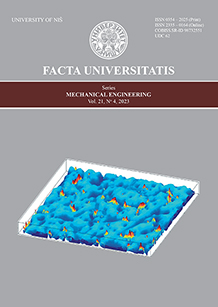利用遗传规划对co2激光切割过程进行数学建模
IF 11.8
2区 工程技术
Q1 ENGINEERING, MECHANICAL
引用次数: 9
摘要
利用实验数据建立数学模型对激光切割过程的建模和优化具有重要意义。由于缺乏关于使用遗传规划(GP)来推导描述激光切割过程的经验数学模型的研究,本研究讨论了遗传规划在开发切口锥度数学模型中的应用。目的是量化三个选定的输入参数(切割速度、激光功率和辅助气体压力)在铝合金AlMg3 CO2激光切割中与切口锥度角的关系。为了获得GP模型演化过程的实验数据库,按照标准的全因子设计规划激光切割实验,其中所选的三个参数在三个水平上变化。结果表明,实验结果与GP模型预测值拟合较好。最后,利用推导的GP数学模型,通过生成三维曲面图,分析了输入参数对切口锥度值变化的影响。本文章由计算机程序翻译,如有差异,请以英文原文为准。
MATHEMATICAL MODELLING OF THE CO2 LASER CUTTING PROCESS USING GENETIC PROGRAMMING
The development of mathematical models by using experimental data is of great importance for modelling and optimization of the laser cutting process. Motivated by the lack of research regarding the use of genetic programming (GP) for deriving empirical mathematical models that describe the laser cutting process, the present study discusses the application of GP to the development of a kerf taper angle mathematical model. The aim was to quantify the relationship between three selected input parameters (cutting speed, laser power and assist gas pressure) and kerf taper angle using GP in the CO2 laser cutting of aluminium alloy AlMg3. To obtain the experimental database for the GP model evolution process, a laser cutting experiment was planned as per standard full factorial design where all three selected parameters were varied at three levels. The fit between the experimental and the GP model prediction values of kerf taper angle was found to be appropriate. Finally, by using the derived GP mathematical model, the analysis of the effects of input parameters on the change in kerf taper angle values was performed by generating 3D surface plots.
求助全文
通过发布文献求助,成功后即可免费获取论文全文。
去求助
来源期刊

Facta Universitatis-Series Mechanical Engineering
ENGINEERING, MECHANICAL-
CiteScore
14.40
自引率
2.50%
发文量
12
审稿时长
6 weeks
期刊介绍:
Facta Universitatis, Series: Mechanical Engineering (FU Mech Eng) is an open-access, peer-reviewed international journal published by the University of Niš in the Republic of Serbia. It publishes high-quality, refereed papers three times a year, encompassing original theoretical and/or practice-oriented research as well as extended versions of previously published conference papers. The journal's scope covers the entire spectrum of Mechanical Engineering. Papers undergo rigorous peer review to ensure originality, relevance, and readability, maintaining high publication standards while offering a timely, comprehensive, and balanced review process.
 求助内容:
求助内容: 应助结果提醒方式:
应助结果提醒方式:


